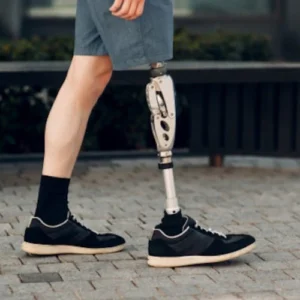
Nice to meet you, 2023. Ready or not, here we come.
We kick things off with some news from the Journal of Gait and Posture, whose January edition features some fresh outcomes data about osseointegration. New evidence on this subject is always welcome, because (as we noted in our feature article about OI back in September) the body of peer-reviewed research on this subject is still pretty shallow; only a few thousand amputees worldwide have undergone this procedure, and a big chunk of them are still OI newbies who haven’t had enough time to adjust to the bone-anchored prosthesis and provide meaningful feedback. But now that we’re two years removed from conditional FDA approval, the data pipeline is starting to fill.
The Gait and Posture paper offers a rigorous clinical examination of one of OI’s presumed benefits: improved balance and gait stability. Conducted by an interdisciplinary team of researchers from the University of Colorado’s pioneering OI center, the study measured the gait characteristics of 10 above-knee amputees pre- and post-osseointegration. Cutting quickly to the chase: This project’s participants became steadier both biomechanically and psychologically after OI, exhibiting a more consistent stride while reporting greater confidence in their walking.
“To our knowledge,” the authors write, “these are the first results to demonstrate the positive effect that osseointegrated prostheses have on static and dynamic balance measures. These results indicate that this novel prosthesis may [reduce] fall risk, which is significant considering the heightened fall risk of patients with amputation who regularly use a socket prosthesis.”
All 10 of the study subjects opted for osseointegration after many years of using conventional socket-based prostheses. They averaged 20 years since date of amputation (with the most recent being six years post-limb loss) and ranged in age from 38 to 55 years old, with an average of 46. The majority of these patients lost limbs due to cancer or trauma; only one had a vascular cause.
To capture data on discrete elements of gait biomechanics, the researchers outfitted each participant with more than 30 sensors to measure walking speed, stride length, center of gravity, ground force, postural sway, and other microcomponents of ambulation. Without getting too technical on you, we can share a few key findings.
First, walking speed actually decreased after OI, which is the opposite of what the researchers expected. Slower pace typically correlates with pain, laborious gait, and/or fear of falling, but the authors suggest that in this instance it indicates increased comfort and confidence. “This is supported by the increased stance time on the amputated limb,” they argue, “which indicates greater confidence and ability to spend a longer amount of time on the amputated limb with an osseointegrated prosthesis as compared to a socket prosthesis. . . . Many patients within our cohort qualitatively reported that when using their osseointegrated prosthesis, they did not feel the same urgency to complete the walking trials due to discomfort experienced within their socket prosthesis.” In short: Greater ease translated into a more leisurely pace.
From a biomechanical perspective, step width and length both became more consistent after osseointegration. Both findings are encouraging, since high variability on these measures is strongly associated with elevated fall risk. Participants also exhibited greater stability while standing, which the authors hypothesize is the result of improved proprioception and osseoperception (defined as the ability to sense force, pressure, gravity, and other mechanical stimuli).
Finally, and perhaps most significant, the participants were significantly more confident on their feet after osseointegration. This value was measured via the Activities-Specific Balance Confidence (ABC) scale, a well-established questionnaire that captures individuals’ subjective, self-reported sense of balance or unsteadiness. Before OI, the study participants averaged ABC scores of about 70 (on a 0 to 100 scale), which is typical for socket-wearing unilateral amputees. Post-osseointegration, the ABC average shot up to the high 80s. “We hypothesize that this population is more confident in their ability to maintain balance as they are more comfortable, have greater prosthesis satisfaction, and increased levels of osseoperception compared to a socket prosthesis,” the authors note, adding that greater confidence supports increased levels of physical activity and social interaction.
“This investigation was the first to demonstrate the effect of osseointegrated prostheses on static and dynamic balance,” the authors concluded. “While this is an important first step in establishing the influence of prosthesis osseointegration on balance, our future work, including a larger sample size, will continue to evaluate balance mechanisms following prosthesis osseointegration to determine if this novel prosthesis lowers fall risk.”
The full paper is online (paywalled) at Gait & Posture via Science Direct.













